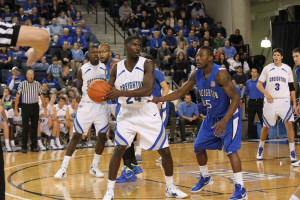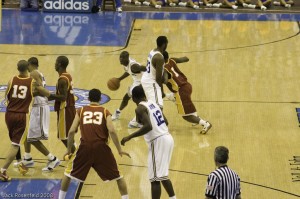Two Solutions for What to do When a Team Offense Breaks Down

A sense of panic for players and coaches is hard to control whenever a Team Offense breaks down. It can happen quickly and without any real indication of what is going to happen in the coming moments of the contest. For some team’s just one instance of this happening during a game can be enough to throw their rhythm off for the entire quarter. However when a team offense breaks down there are some valuable steps to take to help minimise the resulting chaos.
It is worth nothing that in every game most teams will experience some sort of scenario where something in their team offense just does not “click”. To help deal with these situations players must have some exposure to these situations in preparation for when they occur. This means coaches must allow for opportunities within their training sessions for this scenario to be experienced, practiced, and overcome. This can be simply achieved by a coach running a half court five on five drill and calling out “change” (triggering a change in offense) with less than ten seconds (or less) left on the shot clock. What to do? How to create a good scoring opportunity, not just throw away the possession.
The first step to helping a team deal with a breakdown in their offense is to have a Terminal Offensive Phase in the playbook. The Terminal Phase in offense is the play that is run when the half court offensive phase has failed to result in a scoring opportunity. A terminal phase play usually lasts for no longer then five seconds so it is quick and easy to execute. For example into today’s modern game, many team offenses finish with the ever-popular on-ball screen.
The terminal phase while sequentially happening as the play of last resort, can be implemented at any time once the team offense has progressed into the half court. It can be used first to kick-start a tiring team offense or if a team is just looking to speed up the general flow of the game.
The terminal phase play(s) can then also be used as a solution to when a team offense fails to fire. If a player fails to cut, or is not able to get open to receive a pass then a terminal phase play can be run to finish off the possession. A point of note is players must be able to set-up for the play very quickly. Therefore, have players divided into groups of guards and forwards, interior and perimeter players will work best as having players playing specific spots may take too long to set-up in the heat of the battle.

The second step to take in dealing with a breakdown in a team offense is to try and limit it happening in the first place. Many team offenses revolve around a specific movement or progression of stages. While this can never be truly removed from the mindset of a team’s offense, instead of running isolated plays, creating a series of options imbeds a depth and breadth of possible offensive production.
Adding a series of options to an offense allows for the opposition to take away certain passes or movements, but in doing so they expose other opportunities for the offense to attack and obtained advantage. When constructed and well drilled a team offense that is in fact a series is very effective under a majority of situations. In the final stages of development is where the series turns into a system. Where players react instinctively to what is happening on the floor in front of them, instead of a predetermined set of movements it becomes impossible to stop and can only be constrained.
A team offense needs to be developed beyond just learning a primary transition and half-court offense. If this is not the case then a team is doomed to suffer from constant breakdowns and periods of scoring droughts. By implementing a terminal phase and counters then within the team’s offense there will be options. This then becomes an opportunity to find a solution, rather than being stumped by a problem.








Leave a Reply